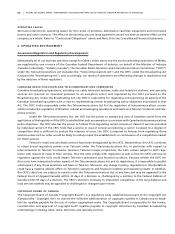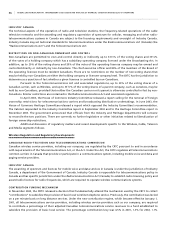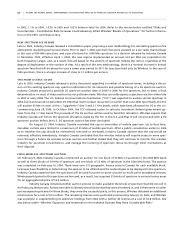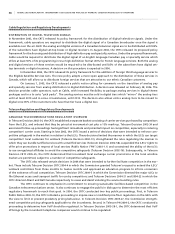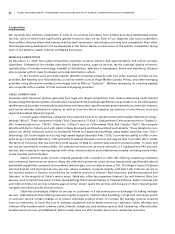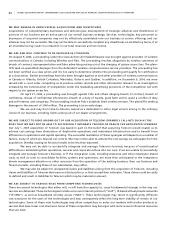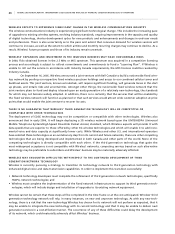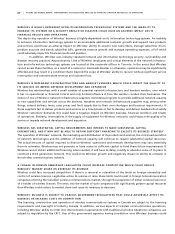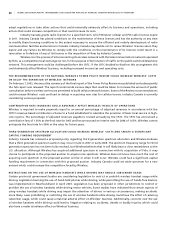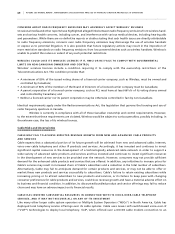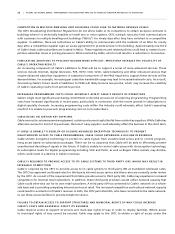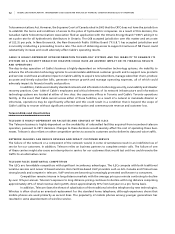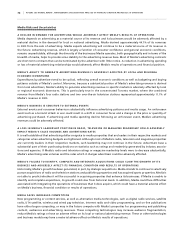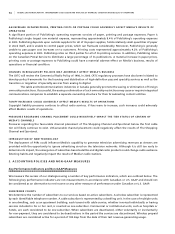Rogers 2005 Annual Report Download - page 68
Download and view the complete annual report
Please find page 68 of the 2005 Rogers annual report below. You can navigate through the pages in the report by either clicking on the pages listed below, or by using the keyword search tool below to find specific information within the annual report.
64 ROGERS 2005 ANNUAL REPORT . MANAGEMENT’S DISCUSSION AND ANALYSIS OF FINANCIAL CONDITION AND RESULTS OF OPERATIONS
WE M AY EN G AG E IN UN S UC C E SS F UL AC Q U IS I TI O NS A ND DI V EST I TU R ES
Acquisitions of complementary businesses and technologies, development of strategic alliances and divestitures of
portions of our business are an active part of our overall business strategy. Services, technologies, key personnel or
businesses of acquired companies may not be effectively assimilated into our business or service offerings and our
alliances may not be successful. We may not be able to successfully complete any divestitures on satisfactory terms, if at
all. Divestitures may result in a reduction in our total revenues and net income.
WE A RE AN D W I L L C ON T IN U E T O B E I N V OL V ED IN L IT I GA T ION
On August 9, 2004, a proceeding under the Class Actions Act (Saskatchewan) was brought against providers of wireless
communications in Canada, including Wireless and Fido. The proceeding involves allegations by wireless customers of
breach of contract, misrepresentation and false advertising arising out of the charging of system access fees. The plain-
tiffs seek un-quantified damages from the defendant wireless communications service providers. The proceeding has
not been certified as a class action and it is too early to determine whether the proceeding will qualify for certification
as a class action. Similar proceedings have also been brought against us and other providers of wireless communications
in Canada in Alberta, British Columbia, Manitoba, Ontario and Québec. In addition, on December 9, 2004, we were
served with a court order compelling us to produce certain records and other information relevant to an investigation
initiated by the Commissioner of Competition under the misleading advertising provisions of the Competition Act with
respect to our system access fee.
On April 21, 2004, a proceeding was brought against Fido and others alleging breach of contract, breach of
confidence, misuse of confidential information, breach of a duty of loyalty, good faith and to avoid a conflict of duty
and self interest, and conspiracy. The proceeding involves Fido’s Inukshuk fixed wireless venture. The plaintiff is seeking
damages in the amount of $160 million. The proceeding is at an early stage.
We are and may from time-to-time be named as a defendant in other legal actions arising in the ordinary
course of our business, including claims arising out of our dealer arrangements.
WE ARE SUB JEC T TO RI SKS ARI SING OU T O F OU R A CQUI SIT ION OF TEL ECOM (F ORME RLY CA LL-N ET) SUC H A S THE
RIS KS THAT WE MAY NO T BE AB LE TO S UCC ESSF ULL Y IN TEG RAT E TE LEC OM O R R EALI ZE THE ANT ICI PATE D S YNERGIE S
Our July 1, 2005 acquisition of Telecom was based in part on the belief that acquiring Telecom would enable us to
achieve cost savings from elimination of duplicative operations and redundant infrastructure and to benefit from
efficiencies in operations and capital spending. The successful realization of these synergies will depend on a number of
factors, many of which are beyond our control. We may not be able to achieve the cost savings we anticipate from the
acquisition, thereby causing its financial results to be less than expected.
We may not be able to successfully integrate and manage Telecom’s business because of unanticipated
difficulties in assimilating their operations, services and corporate culture into our own. If we are unable to successfully
integrate and manage Telecom’s business, or if the integration costs, including severance and other employee related
costs, as well as costs to consolidate facilities, systems and operations, are more than anticipated or the integration
diverts management attention or other resources from the operation of the existing business, then our business and
financial results, including those of our subsidiaries, may suffer.
We may also be subject to unexpected claims and liabilities arising from the acquisition of Telecom, including
claims and liabilities of Telecom that were not disclosed to us or that exceed their estimates. These claims could be costly
to defend and result in liabilities to Telecom which may be material in amount.
WE A RE SU B JE C T T O V A RI O U S R IS K S F R OM CO M PET I NG TE C HNO L OG I ES
There are several technologies that either will, or will have the capacity to, cause fundamental changes in the way our
services are delivered. These technologies include voice over Internet protocol (“VoIP”), IP-based virtual private networks
(“IP-VPNs”), as well as broadband wireless access (“BWA”). These technologies may result in significantly different
cost structures for the users of the technologies and may consequently affect the long-term viability of certain of our
technologies. Some of these new technologies may allow competitors to enter our markets with similar products or
services that have lower cost structures. Some of these competitors may be larger with more access to financial resources
than we have.



